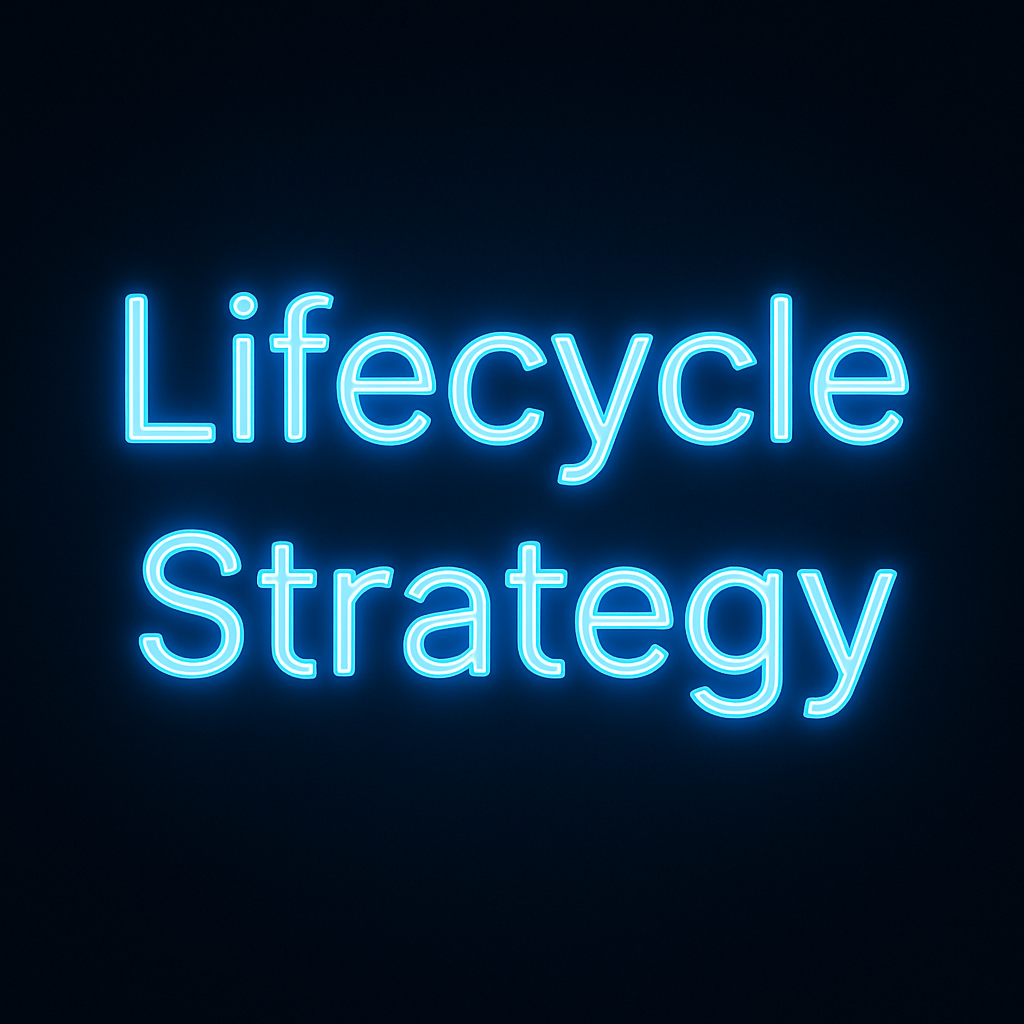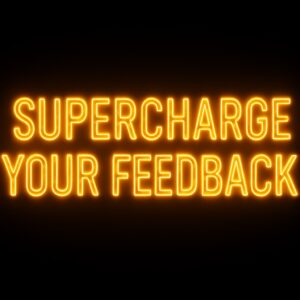Everything has a lifecycle. It is born, it grows, it ages, and it ultimately dies. It’s easy to spot a lifecycle in action everywhere you look. A person is born, grows, ages, and dies. So does a star, a tree, a bee, or a civilization. So does a company, a product, or a market. Everything has a lifecycle.
All lifecycles exist within a dynamic between system development and system stability. When something is born, it’s early in its development and it also has low stability. As it grows, both its development and stability increase until it matures. After that, its ability to develop diminishes over time while its stability keeps increasing over time. Finally, it becomes so stable that it ultimately dies and, at that moment, loses all stability too.
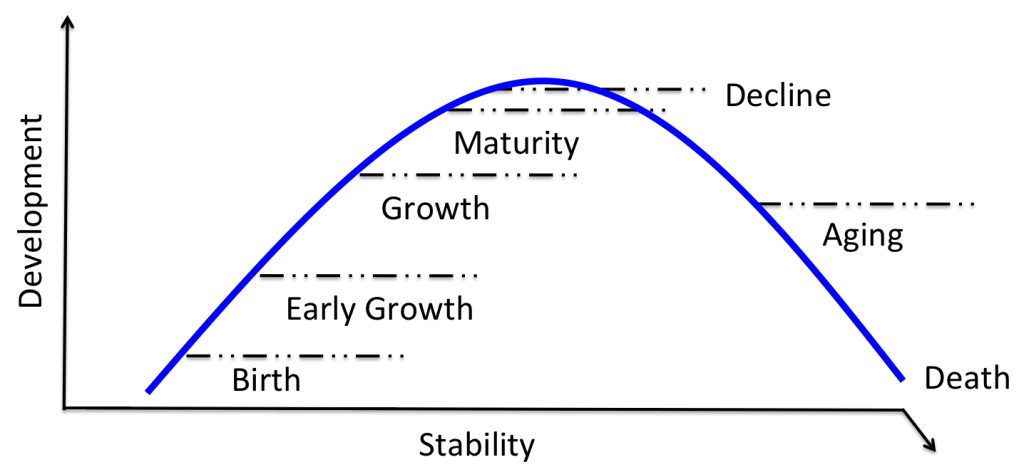
That’s the basics of all lifecycles. We can try to optimize the path or slow the effects of aging, but ultimately every system makes this progression. Of course, not all systems follow a bell curve like the picture above. Some might die a premature death. Others are a flash in the pan. A few live long and prosper. But from insects to stars and everything in between, we can say that everything comes into being, grows, matures, ages, and ultimately fades away. Such is life.
What do the principles of adaptation and lifecycles have to do with your business strategy? Everything. Just as a parent wouldn’t treat her child the same way if she’s three or thirty years old, you must treat your strategy differently depending on the lifecycle stage. And when it comes to your business strategy, there are actually three lifecycles you must manage. They are the product, market, and execution lifecycles.
- The product lifecycle refers to the assets you make available for sale.
- The market lifecycle refers to the type of customers to whom you sell.
- The execution lifecycle refers to your company’s ability to execute.
In order to execute on a successful strategy, the stages of all three lifecycles must be in close alignment with each other. If not, like a pyramid with one side out of balance, it will collapse on itself and your strategy will fail. Why? Because aligning the product, market, and execution lifecycles gives your business the greatest probability of getting new energy from the environment now and capitalizing on emerging growth opportunities in the future. (I discussed in a previous post that the goal of any strategy is to get new energy from the environment, now and in the future.) As you’ll see, aligning all three lifecycles also decreases your probability of making major strategic mistakes.
Before I explain each lifecycle please note that each stage blends into the next. Although I may speak of distinct stages, this is really only for convenience. There’s no real, definitive, clean and clear break where you know when one stage has ended and another begins. In addition, there are three basic prerequisites that you must have before you can pursue any strategy.
First, the strategy must be aligned with the company vision and values. Second, the company must have or be able to get the resources – including staff, technology, and capital – to execute the strategy. Third, the company must have or be able to develop the core capabilities to execute the strategy. For now, I am going to assume that you have all three prerequisites in place and that you’re currently acting on, or about to act on, a strategy that meets these basic requirements.
The Product Lifecycle
The “Product” is the assets you make available for sale, including products and services. Every product goes through a lifecycle that is a trade-off between product development and product stability. The basic stages of the product lifecycle are: Pilot It, Nail It, Scale It, Milk It, or at any time, Kill It. Not every product makes it through each stage. Most products get killed before they ever reach the Pilot It stage. However, if a product is to be successful, then it must move sequentially through each stage (there’s no skipping a stage) by performing a key set of actions.

In the Pilot It stage, the key actions you’ll want to take are asking a lot of questions and testing out your assumptions. At this stage, you should be seeking to innovate with a product that has the potential to disrupt the status quo. You accomplish this by understanding the real dynamics within a market niche and by creating solutions that solve a market problem in a new and better way. At this stage, you must show thought leadership and be able to articulate why your innovative approach is superior. The ultimate goal at this stage is to have early-stage, innovator-type customers who are enthusiastic champions of your approach.
In the Nail It stage, you focus product development on producing tangible, verifiable results for early adopter clients. At this stage, you sacrifice what’s not absolutely essential in the product and relentlessly focus on solving the core customer pain, problem, or need. Your mindset is like a detective’s – you’re investigating what really works and what doesn’t. This requires that you cultivate and collaborate very closely with customer product champions while simultaneously proving and documenting that you have, in fact, solved the market problem. The ideal outcome at this stage is that you’ve built trust and credibility with early adopter clients and you have paying customers who come back to buy more (buying more provides the only real evidence that you have, in fact, nailed it).
In the Scale It stage — because you’ve demonstrated thought leadership and proven that you’ve nailed the product in the prior stages — you’re now in a race to be a niche market leader. You must now accomplish two seemingly contradictory things. First, you must stabilize or standardize the product to achieve economies of scale. This allows you to increase your margins because you can now leverage customers’ willingness to pay (and because you’ve proven that you solve their problem at the prior stage, they will be willing to pay). You can also leverage greater internal efficiencies that come from standardizing the product. Once the product is standardized, you must also create high-value add-on products and services. These add-on products could include new line extensions as well as new applications of the core product offering. The ultimate goal at this stage is to increase your product margins while aggressively capturing market share among early majority clients.
In the Milk It phase, your key actions are to maintain the product for late majority/laggard clients. Now is the time when you attempt to leverage your past thought leadership, proven capabilities, and standardization to defend and expand your relative market share. But instead of investing for long-range product development, you limit additional investment to immediate ROI. That is, if required new product investments can’t demonstrate an immediate payback, you don’t make them at this stage. There’s a constant trade-off to be made between continuing to milk the product and selling it off. Of course, at any time the product can be killed because it’s no longer viable in the marketplace, is longer generating positive ROI, or a buyer cannot be found.
The Market Lifecycle
Just as every product goes through a lifecycle that is a trade-off between development and stability, so does every market. The market lifecycle is segmented into the types of customers (or potential customers) you’re selling to: innovators, early adopters, early majority, and late majority/laggards.

The market lifecycle begins with innovators. This is the group that drives change within their industry. They are technology enthusiasts who tend to be on the lookout for new technologies and new approaches and they are willing to invest time and interest (though usually not money) on vetting them. The key to working with this group is to show thought leadership on why your approach is unique/transformative/better than the status quo and to be straightforward about what your product can and cannot do. You want to get them excited and invested in your view of the world and your product vision and capabilities. Their ultimate endorsement for your approach is essential because it informs the next stage of customers that you are not only innovative but also legitimate and worth investigating further.
The next group of customers is early adopters. This group is seeking a fundamental breakthrough in a core business problem or strategic opportunity. Because you’ve shown thought leadership at the prior stage, this group can now start to see how your product can help them achieve their own vision. That is, if your product can seem to match their ideas of what could be, then they are willing to take substantial risks in time, energy, reputation, and money to help make it so. They are more conceptual than technical. They also find it easy to imagine, understand, and appreciate the benefits of your approach and can relate its potential benefits to their other concerns. This group tends to move and act quickly and they’re usually in a big hurry, putting increasing time pressure on your product development schedule.
It doesn’t matter that your company is small or unproven when working with early adopters. It only matters that you can produce results and help them achieve their vision. They key to working with this group is to collaborate very closely with them to uncover and solve their core problem. This can be challenging because a true early adopter is easy to sell to and very hard to please. They are pursuing their own dream and, consequently, their product demands may be at odds with your own needs to create a universal product with broad market adoption. If you’re not careful, you can end up spending too much time and money on unnecessary product features and functions that don’t apply to later market stages. But if you can work with select clients within this group to define the core business problem, prove that you solve it, and document this with metrics, testimonials, and case studies, then you are ready to market to the next segment, the early majority.
The early majority segment is known as the practical buyers. According to Geoffrey A. Moore, in his book Crossing the Chasm, if a product requires a change in behavior (or a modification of how the early majority customers use other products and services they rely on), then the gap between the needs of the early majority and the prior stage is significant. This gap or “chasm” shows that the psychological profile of the early majority customer is quite different from that of the prior early adopter stage. While the early adopters of the prior stage are willing to take risks and act in isolation, the early majority is much more thoughtful and cautious. They like to make decisions by communicating with others and require a complete product that has demonstrated and proven results before they act. For example, while the early adopter would purchase a product that could deliver an 80% solution (seeing it as only 20% more to go), the early majority would only buy it when it’s 100% complete. The key to capturing the early majority market is to leverage the proof of performance from the prior stage and to standardize the product so that it is reliable, stable, complete, and easy to use.
The fact is that early majority buyers don’t like risk. To them, risk means a potential waste of money and or time. They require stability, are extremely loyal once won over, and will make your product the company standard. And because they spend a good amount of time communicating with others within their own market, they also help to standardize your product across the industry. While the prior stage is driven by the need to achieve a vision or find a breakthrough solution, this stage is all about making sure things are done properly and that the buyer’s own reputation is not put at risk. They will focus on the quality of the product, the infrastructure to support the product, and the reliability of service. They’ll even want to ensure that you have competition in the marketplace so they can verify that they’re purchasing from a proven market leader. They are price-sensitive in that, in the absence of any special differentiation, they will want a good deal.
Finally, the last stage is the late majority/laggards. It is this group that is resistant to new products until they have become the industry norm. They wait until something has become an established standard and tend to buy from large, well-established companies. They purchase only when products are extremely mature, competition in the marketplace is driving low prices, and the products themselves can be treated as commodities. Basically, they like to buy preassembled packages, with everything bundled, at a heavily discounted price. The key to selling to this segment is to be the established leader in the space, to have economies of scale, and to dominate the major distribution channels.
The Execution Lifecycle
Just like the other lifecycles, the execution lifecycle exists within a dynamic between stability and development. The basic stages of the execution lifecycle are birth, early growth, growth, and maturity and from there things descend into decline, aging, and death. The focus within the execution lifecycle should be to have the right mix of organizational development and stability to support the stages of the product and market lifecycles. That is, the lifecycle stage of the surrounding organization should generally match the lifecycle stage of the products and markets. If it’s a startup, the surrounding organization is the entire company. If it’s a Fortune 500 company, this includes the business unit that is responsible for the success of the product as well as any aspects of the parent organization that influence, help, or hinder the success of the product.
The stages of the execution lifecycle become easier to understand with a little pattern recognition. Basically, every business must shape or respond to its environment and it must do so as a whole organization, including its parts and subparts. If it doesn’t do so, it will cease to exist. Recognizing this, we can call out four basic patterns or forces that give rise to individual and collective behavior within an organization. They are the Producing, Stabilizing, Innovating, and Unifying (PSIU) forces. Each of these expresses itself through a particular behavior pattern. The combination of forces causes the organization to act in a certain way.
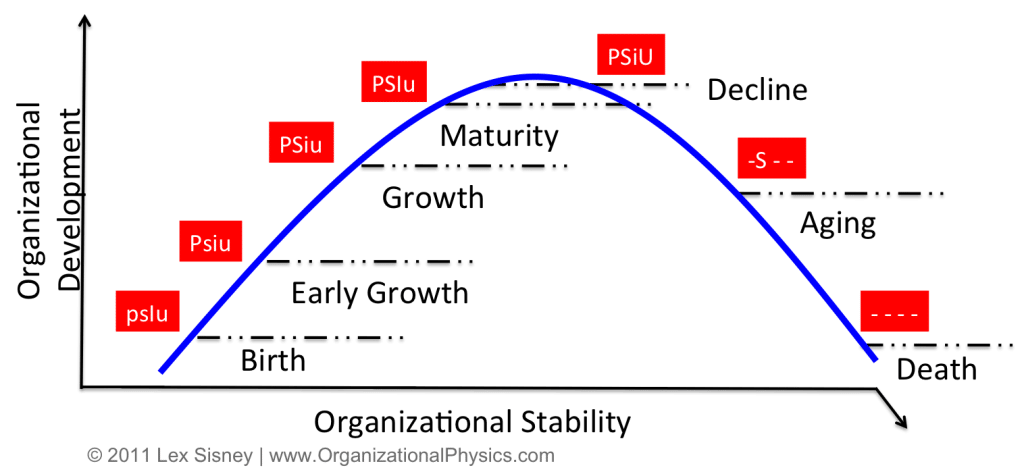
The surrounding organization should act a certain way at each stage of the product/market lifecycle, as you’ll see below. Note that, when a force is or should be dominant, it will be referenced with a capital letter:
• When piloting the product for innovators, it should be in birth mode and be highly Innovative and future-oriented (psIu)
• When nailing the product for early adopters, it should be in early growth mode and be Producing verifiable results for its customers (Psiu)
• When beginning to scale the product for the early majority, it should be Standardized and operations streamlined for efficiency (PSiu)
• When fully scaling the product for the early majority, its internal efficiencies should be harnessed, as well as the capability to launch new innovations and avoid the commodity trap (PSIu)
• When milking the product for the late majority/laggards, the company should use the proceeds from the cash cows to launch new products into new markets that will in turn progress through their own lifecycle stages.
Intuitively it should make sense that an organization should align its internal environment to closely match the product and market fit. The reality is that most startups fail to do this. For example, imagine an entrepreneurial startup that has one nascent product and attempts to launch a new one at the same time. Like a teen pregnancy, it’s way too soon to be having offspring. The teen isn’t mature, stable, capable enough of raising babies of her own. Similarly, the startup needs to reach scalable growth mode (where there’s standardization, positive cash flow, and strong capabilities) before it attempts to launch new business units.
But just as a teen pregnancy is bad, having kids as a geriatric patient is unwise too. For instance, imagine an aging company with a large cash hoard that acquires a smaller, growth-oriented business. Because the acquirer is so aging, heavy, and stable, it smothers the entrepreneurial zeal and doesn’t allow the new acquisition to flourish. The same thing occurs when an aging company attempts its own in-house intrapreneurship but doesn’t allow the new business unit the freedom and flexibility it needs early in its development. Perhaps it forces the new unit to follow existing company procedures or to work within the existing businesses infrastructure. All of these demands create an environment that is too stable, heavy, and bureaucratic for a new company to thrive.

Of course, the execution lifecycle does not usually look like a neat bell curve. Most new organizations never make it past the first few stages before falling off the curve into a premature death. That is, even though they’re young in months, new startups will run into trouble by acting “old” and soon die. Other businesses spend years, even decades, trying to escape one stage of the lifecycle without making the leap to the next stage. Some businesses shoot up the curve really quickly only to come down just as quickly. My speciality is helping organizations navigate the execution lifecycle. It is a great challenge and doing it correctly warrants its own section that I’ll include later in this series.
The Real Question You Should Be Asking
When it comes to planning your strategy, the real question you should be asking yourself is not, “What should we do next?” but rather, looking at the product/market/execution lifecycles: “Where are we now?” As you look at the graphic below, place each of your products (or business unit groupings of multiple products) where you think it most likely resides on the blue arch. For example, if your product is in the Nail It stage, then place it in the Nail It section.
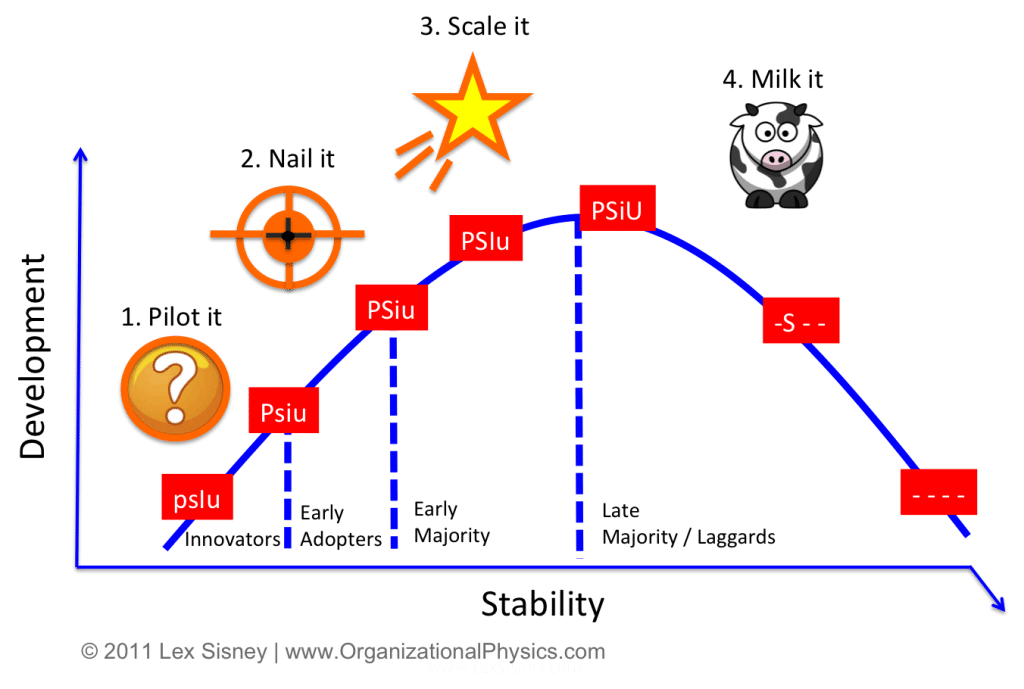
In the coming sections I will share with you the key indicators that will reveal if your product/market/execution lifecycles are misaligned. I will also explain the well-defined path to strategic success – as well as the three strategic follies you must avoid at all costs. You’ll be able to view each product on its lifecycle curve and then determine if it’s aligned with the execution and market lifecycles.
Are you in the right place, at the right time, doing the right things? Or are you in a strategic folly?
Back to Tutorials.
